Clermont Huet Sr 8x20
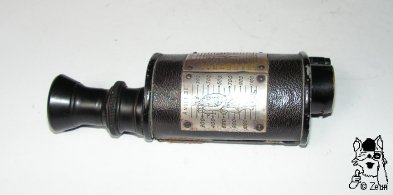
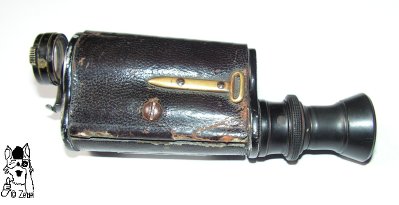
| Dieses 8x20 Porro-1-Monokular wird im Huet-Katalog um 1905 als "forme triangle", also 'Dreiecksform' bezeichnet, wobei die Gehäusedeckel allerdings einen nierenförmigen Grundriss haben. Typisch für Huet-Gläser ist die Geradführung des Okulars beim Fokussieren. Der Fokussierungsring aus Metall ist oben, d.h. bei Benutzung zum Betrachter hin ausgerichtet und somit ablesbar, mit einer Dioptrienskala von plus bis minus Zehn gekennzeichnet, dabei ist die Beschriftung mit "0", + und - sowie Fünfen ebenfalls so angeordnet, dass sie beim Halten ans Auge aufrecht lesbar bleibt. Die trichterförmige Bakelit-Augenmuschel ist im Innenrand mit "Clermont Huet Sr Paris" beschriftet. Die Aluminiumdeckel sind dreifach verschraubt und schwarz lackiert; der obere trägt die Gravur "8x". Das Aluminiumgehäuse ist mit Leder ummantelt und hat eine halblange Trageriemenöse angeschraubt. | This 8x20 porro 1 monocular is listed in a 1905 catalogue by Huet as "forme triangle", i.e. triangle shape, although the cover plates rather have a kidney-shaped outlines. A typical feature of Huet glasses is its linear movement of the ocular. The metal focusing ring is marked with a dioptre scale ranging from plus to minus ten. It is inscribed with zero, plus and minus as well as five on top of the focusing ring in such a way that the user can read upright numbers when holding the monocular horizontally to his or her eye. The cone-shaped eyecup is inscribed with "Clermont Huet Sr Paris" at its inner rim. The aluminium covers have three screws and are painted black. The top cover is marked "8x". The aluminium housing is covered with leather and has a screwed-on strap lug across half the length of the body. |
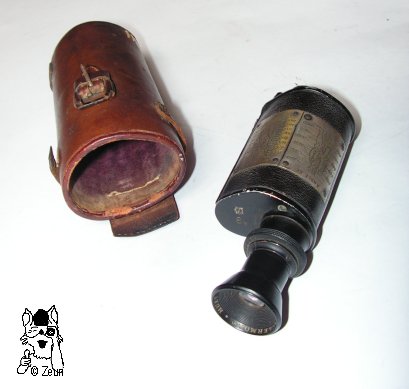
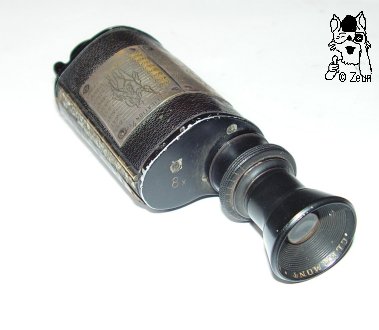
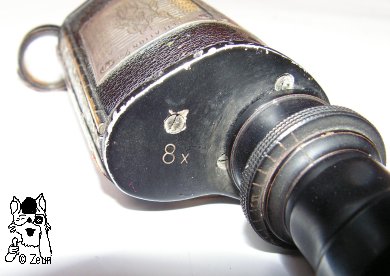
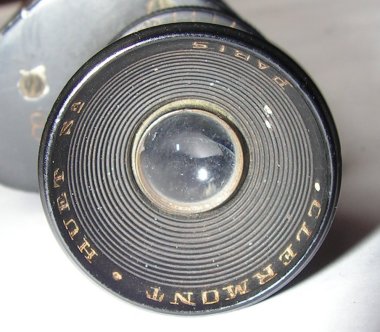
| Das Monokular wurde für militärische Zwecke so entwickelt, denn es hat zwei weitere Besonderheiten. Zum einen sind an das Gehäuse zwei Telemeter-Platten angenietet, die in Kombination mit der vor das Objektiv klappbaren Kalkspat-Zweitlinse zur Entfernugnsmessung dienten. Durch Vergleich der Höhe eines anvisierten bekannten Objekts bzw. eines Kavalleristen oder Artelleristen und der abweichenden Höhe - abgelesen in Strichen - bei vorgeklappter Zweitlinse, lässt sich anhand der Striche auf den entsprechenden Meßplatten (Telemetern) die Entfernung abschätzen. Die Telemeterplatten sind mit Abbildungen eines berittenden und eines Fußsoldaten sowie Referenzlinien mit Ziffern markiert; die Umrechnung wird mit "Angle de Duplication 1/325" (Winkel zur Verdopplung 1/325) angegeben. Die Zweitlinse lässt sich in einem Trägerring (mit Stempelung "12") drehen. Dieser ist an einer neben dem Objektiv geschraubten Achse beweglich. | The monocular was constructed for military use which is obvious for two special features. First two telemeter plates are riveted to the housing which serve range finding in combination with a second swing-in calcite lens at the objective. Comparing the height of a cavalry or artillery man or a known observed object with the difference in height measured in lines when the calcite lens is swung in you can judge his or its distance by reading the corresponding numbers and lines on the telemeters. The telemeter plates picture a cavalerist or an artillerist, and reference lines with numbers. The needed distance calculation is marked as "Angle de Duplication 1/325" (angle for duplication 1/325). The calcite lens can be swung in front of the objective lens. It is mounted on a brass ring stamped "12", turning on an screwed-on axis next to the objective. |
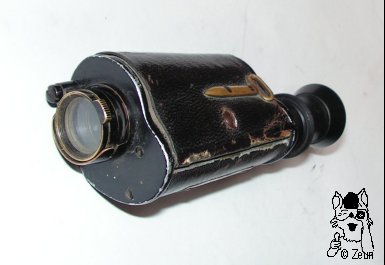
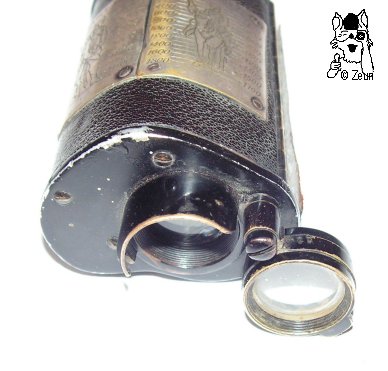
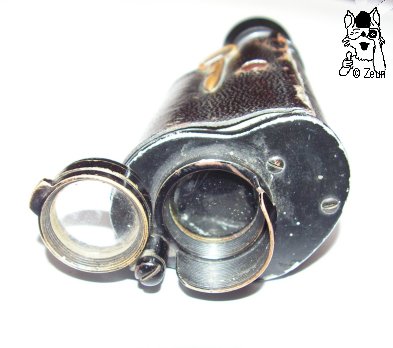
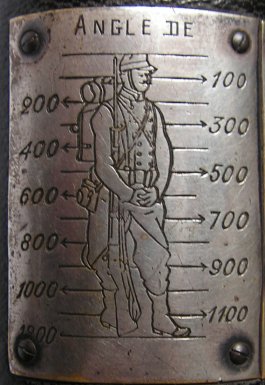
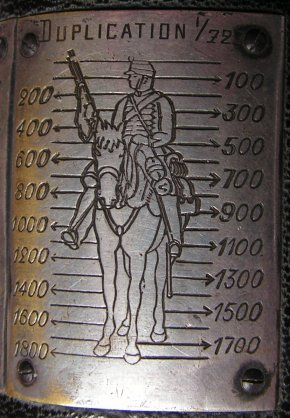
| Zum anderen kann man seitlich das Gehäuse aufklappen, um die Prismen zu reinigen. Mittels einer Schraube lässt sich die Klappe innen verriegeln. Sie ist mit einem Scharnier am festen Gehäuseteil verbunden. Im geöffneten Gehäuse sieht man die Prismenbefestigung auf "Zwischenböden" und festgeklemmt mit Metallfedern. Beide Gehäuseteile sind innen mit M8 gestempelt, der Klappdeckel ist auch mit "ETÉ EN FRANCE ET A L'ÈTRANGER" (= in Frankreich gefertigt und im Ausland" gestempelt. | Second the housing can be opened at one side for servicing and cleaning. This housing door can be locked by turning a screw. It is hinged to the fixed body part. When opened one can see the prism cage construction with sort of intermediate floors and springs fixing the prisms. Both housing parts are stamped with "M8". Moreover, the door piece is also marked "ETÉ EN FRANCE ET A L'ÈTRANGER" (= made in France and abroad". |
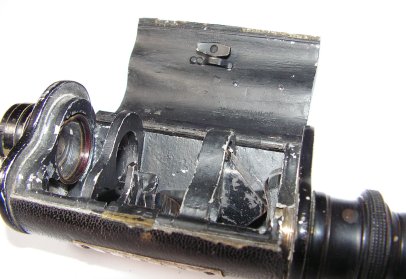
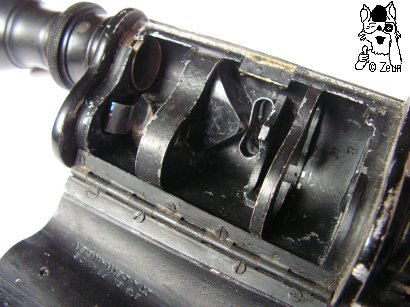

| Das Monokular wiegt ohne Behälter 255g. Es ist 140-150mm lang, das Gehäuse oben 33x48mm und unten 37x51mm breit sowie 78mm hoch. Die Tragerienenöse ist 39mm lang. Der Fokussierungsteil des Okulars ist an der Taille 21mm, am Fokussierungsring 28mm, das Okularstück 16mm, die Augenmuschel am Schaft 18mm und oben 30mm im Durchmesser. Die Objektivlinsenfassung ist 26mm, die schwenkbare Fassung der Zweilinse 22mm im Durchmesser. Die Objektivfassung steht 13mm hervor. | The monocular weighs 255g without its case. It is 140-150mm long, measuring 33x48mm at the top and 37x51mm at the bottom of the 78mm tall housing. The strap lug is 39mm long. The focusing piece of the ocular is 21mm at its narrow part, 28mm at the focusing ring , the eyepiece 16mm in diameter. The eyecup is 18mm at its shaft and at its end 30mm in diameter. The objective lens frame is 26mm, the swing-in frame of the calcite lens is 22mm in diameter. The objective frame protrudes 13mm. |
Fotos: Zeun

